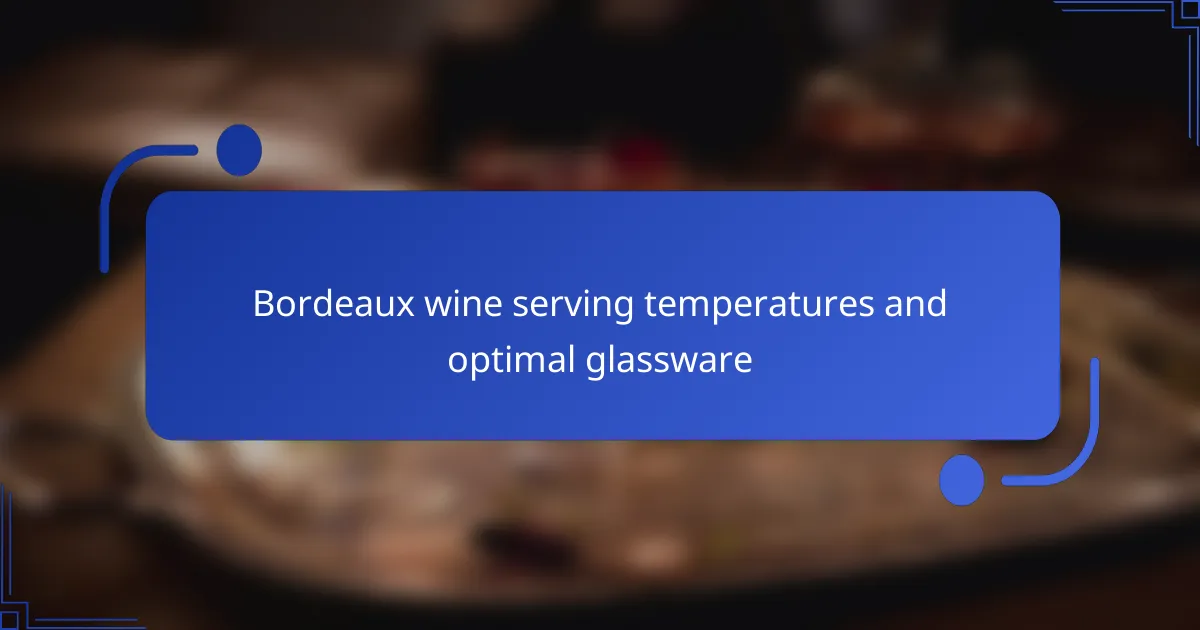
What are the ideal serving temperatures for Bordeaux wine?
The ideal serving temperature for Bordeaux wine is between 60°F to 65°F (15°C to 18°C). This temperature range allows the wine’s flavors and aromas to fully express themselves. Serving red Bordeaux at this temperature enhances the wine’s complexity. For white Bordeaux, the ideal serving temperature is slightly cooler, around 50°F to 55°F (10°C to 13°C). This cooler temperature preserves the wine’s crispness and acidity. Serving Bordeaux wine at these temperatures is recommended by wine experts and sommeliers to ensure an optimal tasting experience.
How do serving temperatures affect the taste of Bordeaux wine?
Serving temperatures significantly affect the taste of Bordeaux wine. Red Bordeaux wines are best served between 60°F to 65°F (15°C to 18°C). At this temperature range, the wine’s aromas and flavors are more pronounced. Serving Bordeaux too warm, above 70°F (21°C), can enhance alcohol perception and mask fruit flavors. Conversely, serving it too cold, below 55°F (13°C), can mute the wine’s complexity and tannin structure. Studies show that temperature influences the volatility of aromatic compounds, affecting overall taste perception. Proper serving temperatures ensure a balanced expression of Bordeaux’s character and enhance the tasting experience.
What specific temperature ranges are recommended for different types of Bordeaux wine?
Red Bordeaux wines are best served at 60-65°F (15-18°C). This temperature enhances their complex flavors and aromas. Full-bodied reds, like Cabernet Sauvignon, benefit from the higher end of this range. Medium-bodied reds, such as Merlot, can be served slightly cooler, around 55-60°F (13-15°C).
White Bordeaux wines are recommended to be served at 45-50°F (7-10°C). This cooler temperature preserves their crispness and acidity. For sweet Bordeaux wines, the ideal serving temperature is between 50-55°F (10-13°C). This range allows the sweetness to shine while maintaining balance.
These temperature guidelines are widely accepted by sommeliers and wine experts. Proper serving temperatures enhance the overall tasting experience.
Why is temperature control important for preserving Bordeaux wine quality?
Temperature control is crucial for preserving Bordeaux wine quality. Proper temperature regulation prevents undesirable chemical reactions that can spoil the wine. Bordeaux wines are best stored at temperatures between 50°F and 55°F (10°C to 13°C). This range helps maintain their flavor profile and aroma. Excessive heat can accelerate aging and lead to off-flavors. Conversely, too low temperatures can inhibit the wine’s development. Consistent temperatures also protect the cork from drying out or becoming too moist. Studies indicate that fluctuations in temperature can negatively impact wine quality over time. Therefore, maintaining optimal temperature conditions is essential for preserving the integrity of Bordeaux wines.
What factors influence the optimal serving temperature of Bordeaux wine?
The optimal serving temperature of Bordeaux wine is influenced by several factors. These factors include the type of Bordeaux wine, its age, and the specific grape varieties used. Red Bordeaux wines are typically served at a temperature range of 60 to 65 degrees Fahrenheit. This range enhances the wine’s aroma and flavor profile. In contrast, white Bordeaux wines benefit from being served cooler, around 50 to 55 degrees Fahrenheit.
The age of the wine also plays a crucial role. Younger wines can handle slightly warmer temperatures, while older wines are better at cooler temperatures to preserve delicate flavors. Additionally, the serving vessel can affect temperature retention. A thin glass may allow the wine to warm more quickly than a thicker one.
Understanding these factors ensures that Bordeaux wine is enjoyed at its best. Proper serving temperatures enhance the overall tasting experience.
How does the vintage of Bordeaux wine impact its serving temperature?
The vintage of Bordeaux wine influences its serving temperature by indicating the wine’s age and development. Older vintages typically require slightly warmer serving temperatures to enhance their complex aromas and flavors. For example, red Bordeaux wines are best served at 60-65°F (15-18°C) when they are younger. As Bordeaux wines age, serving temperatures can rise to 65-70°F (18-21°C) to allow the subtleties of the wine to emerge. This adjustment is crucial for appreciating the nuanced characteristics of older vintages. Research shows that serving temperature significantly impacts the perception of taste and aroma in wine. Therefore, understanding the vintage is essential for optimal enjoyment.
What role does the grape variety play in determining serving temperature?
Grape variety significantly influences the optimal serving temperature of wine. Different grape varieties exhibit unique flavor profiles and acidity levels. For instance, red wines made from Cabernet Sauvignon are best served at slightly warmer temperatures, around 60-65°F. This warmth enhances the wine’s bold flavors and tannins. Conversely, white wines from Sauvignon Blanc are ideally served chilled, around 45-50°F, to preserve their crispness and acidity. The chemical composition of each grape variety affects how temperature impacts aroma and taste. Research indicates that serving temperature can alter the perception of sweetness and acidity in wine, further emphasizing the importance of grape variety.

What types of glassware are best for serving Bordeaux wine?
The best types of glassware for serving Bordeaux wine are Bordeaux glasses and large-bowled red wine glasses. Bordeaux glasses have a broad bowl that allows for better aeration. This design enhances the wine’s aromas and flavors. Large-bowled red wine glasses also provide ample space for swirling. Swirling the wine increases oxygen exposure and releases more complex scents. These glasses typically have a slightly tapered rim. The tapered rim helps concentrate the aromas towards the nose. Using the right glassware significantly improves the overall tasting experience. Studies in wine appreciation indicate that glass shape influences flavor perception.
Why is the choice of glassware important for Bordeaux wine?
The choice of glassware is important for Bordeaux wine because it enhances the wine’s aromas and flavors. Bordeaux wines are typically full-bodied and benefit from a larger bowl shape. This design allows for better aeration, which releases the wine’s complex bouquet. The glass’s narrow rim directs the wine to the appropriate part of the palate. This enhances the tasting experience by emphasizing the wine’s richness and tannins. Studies show that the right glass can significantly improve the perception of wine characteristics. For example, a study by the University of California found that glass shape affects the aroma intensity perceived by tasters. Therefore, using the correct glassware is essential for fully appreciating Bordeaux wine.
What specific characteristics should Bordeaux wine glasses have?
Bordeaux wine glasses should have a large bowl and a tapered rim. The large bowl allows for better aeration of the wine. This feature enhances the wine’s aromas and flavors. A tapered rim directs the wine to the center of the palate. This design helps to balance the wine’s acidity and tannins. Bordeaux glasses are typically made from thin glass. Thin glass enhances the visual appeal and allows for better temperature control. The overall shape is designed to complement the bold characteristics of Bordeaux wines. These characteristics ensure an optimal tasting experience.
How does glass shape influence the aroma and flavor of Bordeaux wine?
The shape of the glass significantly influences the aroma and flavor of Bordeaux wine. A wider bowl allows for greater surface area exposure to air. This exposure enhances the wine’s aromatic compounds, promoting a more intense bouquet. The tapered rim directs aromas towards the nose, improving olfactory perception. Bordeaux wines, known for their complex profiles, benefit from this enhanced aroma delivery. Studies indicate that the right glass shape can elevate the tasting experience. For instance, a Riedel Bordeaux glass is designed to optimize the characteristics of these wines. This specific design supports the wine’s structure and balance, allowing flavors to unfold more fully.
What are the different types of glassware suitable for various Bordeaux wines?
Bordeaux wines are best served in specific types of glassware designed to enhance their characteristics. The standard glass for Bordeaux is a large, bowl-shaped glass. This design allows for better aeration of the wine.
For red Bordeaux wines, a glass with a wide bowl is recommended. It helps to release the wine’s aromas and flavors. For younger Bordeaux, a larger glass can be beneficial, as it allows more air contact.
For white Bordeaux wines, a narrower glass is suitable. This shape helps maintain the wine’s crispness and acidity.
Additionally, for dessert Bordeaux wines, smaller glasses are often preferred. They concentrate the aromas and flavors in a more focused manner.
Using the appropriate glassware can significantly enhance the tasting experience of Bordeaux wines.
What are the benefits of using a Bordeaux glass versus a universal wine glass?
Bordeaux glasses enhance the tasting experience of Bordeaux wines more effectively than universal wine glasses. They have a larger bowl that allows for better aeration of the wine. This aeration releases the wine’s complex aromas, enhancing the overall sensory experience. The shape of a Bordeaux glass directs aromas towards the nose, improving olfactory perception. Additionally, the wider opening helps to soften tannins, making the wine smoother on the palate. Universal wine glasses lack this specific design, which can limit the appreciation of Bordeaux wines. Studies indicate that wine served in an appropriately shaped glass can improve flavor perception by up to 20%. This demonstrates the significant benefits of using a Bordeaux glass for these specific wines.
How does the size of the glass affect the serving experience of Bordeaux wine?
The size of the glass significantly influences the serving experience of Bordeaux wine. A larger glass allows for greater aeration, enhancing the wine’s aromas and flavors. This is crucial for Bordeaux wines, which often have complex profiles. The increased surface area promotes evaporation of volatile compounds, improving the overall sensory experience. Research indicates that a glass with a capacity of 12 to 14 ounces is optimal for Bordeaux. This size allows for a proper swirl, releasing aromatic compounds. Additionally, the shape of the glass can direct aromas to the nose more effectively. Studies show that the right glassware can elevate the perception of quality in wine.

How can I enhance my Bordeaux wine serving experience?
To enhance your Bordeaux wine serving experience, serve it at the optimal temperature of 60-65°F (15-18°C). This temperature range allows the wine’s aromas and flavors to fully develop. Use a Bordeaux glass, which has a wide bowl and a tapered rim. This design helps concentrate the wine’s bouquet. Allow the wine to breathe for at least 30 minutes before serving. Aeration softens tannins and enhances complexity. Additionally, consider decanting older Bordeaux to separate sediment. Proper serving enhances the overall enjoyment of this prestigious wine.
What practical tips can improve serving temperatures and glassware choices for Bordeaux wine?
Serve Bordeaux wine at temperatures between 60°F to 65°F (15°C to 18°C). This range enhances the wine’s flavors and aromas. Use a wine thermometer for accuracy. Cooling the bottle in an ice bucket for 15-20 minutes is effective.
Choose a Bordeaux glass, which has a broad bowl and a tapered rim. This design allows for better aeration and concentration of aromas. The glass should hold about 12-14 ounces. Ensure the glass is clean and free of residues for optimal tasting.
These practices are supported by wine experts who emphasize temperature and glass shape’s impact on wine experience.
How should I store Bordeaux wine to maintain optimal serving conditions?
Store Bordeaux wine in a cool, dark place. Ideal storage temperature ranges from 50°F to 55°F. Maintain consistent humidity levels around 70%. Use a wine cellar or a dedicated wine fridge for best results. Place bottles horizontally to keep corks moist. Avoid direct sunlight and vibrations, as they can damage the wine. Proper storage enhances the wine’s flavor and longevity. Studies show that temperature fluctuations can negatively affect wine quality.
What common mistakes should be avoided when serving Bordeaux wine?
Common mistakes to avoid when serving Bordeaux wine include serving at incorrect temperatures. Bordeaux red wines should be served slightly below room temperature, ideally around 60-65°F (15-18°C). Serving them too cold can mute their flavors. Additionally, using inappropriate glassware is a mistake. Bordeaux wines benefit from larger, tulip-shaped glasses that enhance their aromas. Pouring too much wine into the glass is another error. Ideally, fill the glass to one-third full to allow for proper aeration. Lastly, not decanting older Bordeaux wines can lead to a less enjoyable experience. Decanting helps separate sediment and allows the wine to breathe.
Bordeaux wine is a renowned entity in the wine industry, with specific serving temperatures and glassware that enhance its tasting experience. The article outlines the ideal serving temperatures for both red and white Bordeaux wines, emphasizing the importance of temperature control in preserving wine quality and flavor profiles. It also discusses the role of glassware in maximizing aroma and flavor, detailing the characteristics of suitable glasses for different types of Bordeaux. Key factors influencing serving temperatures, such as grape variety and vintage, are examined to provide a comprehensive understanding of how to best enjoy Bordeaux wine.
